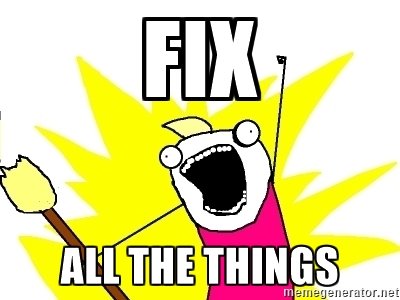Understanding US Healthcare Chapter 1 - Co-payments, Deductibles, Coinsurance and Out of Pocket Maximums...
Greetings steemians and welcome to the first chapter of this educational series on US Healthcare and how to better understand it!
For those of you who might of missed my feeler post on Monday I want you to know that I have been in the Health Insurance industry for the better part of a decade. That time includes before, during and after the implementation of the individual provisions of the Affordable Care Act and Health Care Reform in general.
As debate about the current and future state of US Healthcare continues to get more spotlight in both the presidential arena and in state legislation, my goal here is to educate about the core components of health insurance plans so that you will be able to make your own educated and informed decision on whether or not a proposed alternative to the current Healthcare program is good for you, good for the public or fundamentally flawed without relying solely on ad campaigns and lobbyists who often only tell you specific positives or negatives to swoon you one way or the other. At the very least, you should be able to know what questions to ask.
That being said, Healthcare and the Insurance for Healthcare industries are large, complicated, and as most people can relate, expensive. To fully appreciate and understand it we're going to have to tackle little chunks at a time. That being said, I strongly encourage you to ask questions or comment below so I can adjust my future curriculum to address what questions you are naturally being led to based on your personal experiences or the content.
Let's Begin!

As good a place as any to start on our long road to understanding US Healthcare is where it probably hits you, the patient, the hardest: What you pay.
Generally, what the patient winds up paying in bills can be lumped up into one of three things:
- A co-payment
- A deductible
- A coinsurance
Fun fact: all three of those words are in the bottom 10-30% of popularity among all words in the Merriam-Webster dictionary, and for good reason!
First, the co-payment or "copay" for short.
Outside of your annual premiums the copay is typically the first real expense you encounter when going to the doctor or the pharmacy. Copays are amounts that are always collected at the time of service and often do not pay for the service in full. You may recognize the cost being somewhere to the tune of $10-$25 when you go see your regular doctor, or $50-$75 for an Urgent Care visit or as high as $100-$200 when you are sick or injured enough to go to the Emergency Room. The copay is what you will always have to pay at the time of service before any other benefits apply from your insurance.
Next up is the deductible
The deductible is the amount of money you have to pay towards your doctor/hospital bills before the insurance starts paying anything on specific services. After paying your copay and the doctor/hospital submits your bill to the insurance the insurance then determines the appropriate cost of the services rendered referred to as "the allowable" (we'll go over this term in a future chapter). Your insurance company then reviews their logs to see how much money you've paid towards your deductible so far in the policy's year. Until you've paid up to your deductible amount you'll be paying the full "allowable" less the copay you already made in the office. Important note: what you pay for the copay does not help you meet the total deductible you are required to pay before benefits are paid by insurance. The deductible amount for most policies normally are anywhere from $500 to $4000. Deductible amounts have been the most frequently changing component of health insurance plans in the past several years.
Once you do hit that, glorious, magically number though- that is when the insurance finally starts paying.

That is when we encounter... the coinsurance.
What the coinsurance refers to depends on the context. When you're with your Human Resources representative in the next couple of months during your open enrollment, talking about your choices for a health plan next year the paperwork usually lists what the insurance is going to pay. Generally, it is 80% for in network services or, if covered, around the 60% mark for out of network services. (We'll go over in network and out of network in a future chapter)
Once you meet your deductible, that is where most people feel happier about going to the doctor for the rest of the year. From that point forward, if the coinsurance is 80% then you're only going to be paying the remaining 20% after your copay.
Example:
Fictional person generically named Jane paid a $20 copay at her in network doctor's office because she had a bad case of the flu and really needed some help. The doctor bills Jane's insurance $300 because that is his standard rate. The insurance reviews the claim and says the allowable for the services performed is actually only $120. Since the provider is in network, the $180 difference here is considered "provider write-off" (this will be explained in a later chapter). The insurance at this point is only considering the $120 to be valid charges from the doctor. Jane had already met her deductible earlier in the year because she has a couple of boys that like to fall out of trees, so the insurance makes the following determination:
$120- $20 copay (Jane already paid the copay)
$100 remaining, and the deductible already met.
80% of $100= $80
Insurance issues a check to the doctor for $80
$100-$80= $20, this is the additional amount Jane owes.
The total cost for Jane for that visit was $40.
Had Jane not met her deductible for the year, should would have paid the full $120 (copay+remaining allowable)
The insurance company keeps note of the money that Jane is having to spend much like they did with the deductible. The reason why, is that most insurance plans have one last monetary component:
The Out of Pocket Maximum (OOPM)
The Out of Pocket Maximum is plainly defined as the money that you have to pay out of pocket before your insurance pays 100% coinsurance. It is a safeguard and a subconscious goal for those who unfortunately have to frequent the hospitals due to a variety of health issues (or children who climb and fall from trees). It is that comforting reassurance that if you get into a really bad accident today that this number is the most money you'll have to spend on medical bills and subsequent care in a single insurance plan's year. Do you remember the example near the bottom of my first post? The Out of Pocket Maximum is how I knew it was wrong, and should be the biggest, flashiest sign that something is wrong with the way your hospital is billing you. The out of pocket maximums can vary from plan to plan, but I've seen them as high as $7,000. The moment I saw that $60,000 bill and they said they had insurance I knew that there wasn't a way that could be right. The most they should be out of pocket was 7k, but they've obviously had prenatal visits the whole year. In a future chapter, I'll go over the specifics of what was actually wrong, but for now it is off topic. Back to topic- that feeling of finally meeting the out of pocket maximum- If the glory of having your insurance pay 80% of the bill made you feel good for the last few months, it feels even better when they pay everything but the copay. Some plans even waive the copay after you've hit your OOPM!
When you meet your out of pocket maximum, that is when you call your doctor and proudly declare:

And then shortly after...

Closing remarks
I've outlined above the most important factors to a health insurance plan in the eyes of the consumer, the patient, you. It is your bottom dollar. When you go through open enrollment the very minimum things you should understand before picking a plan are:
- What are my copays?
- What is the deductible?
- What is my out of pocket maximum?
- What are the differences in each choice's premiums?
Take note, the lower the copay, deductible or OOPM- the higher your premiums are going to likely be. The higher the copay, deductible or OOPM, the less your premiums should be. If you or your family frequent the hospital either due to illnesses, diseases or accident prone tree climbing children- you'll probably want to go with a low copay/deductible/OOPM plan and pay the little bit extra in premiums. If you never, ever go to the doctor you can go for a low premium high copay/deductible/OOPM plan but you are risking having to pay more for an unexpected emergency.
That's all for today! Remember to ask questions or add comments below and let me know if the content was helpful or enlightening!
Congratulations @youngblood! You received a personal award!
You can view your badges on your Steem Board and compare to others on the Steem Ranking
Do not miss the last post from @steemitboard:
Vote for @Steemitboard as a witness to get one more award and increased upvotes!